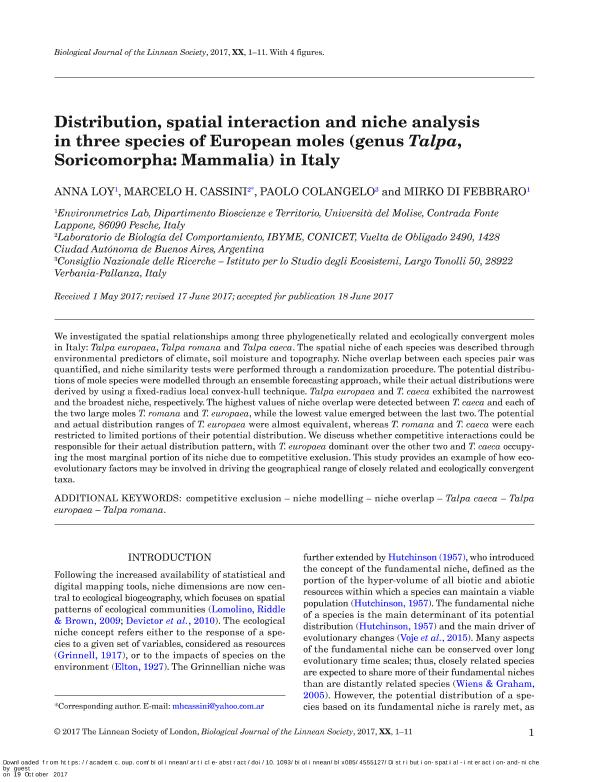Artículo
Distribution, spatial interaction and niche analysis in three species of European moles (genus Talpa, Soricomorpha: Mammalia) in Italy
Fecha de publicación:
12/2017
Editorial:
Wiley Blackwell Publishing, Inc
Revista:
Biological Journal of The Linnean Society
ISSN:
0024-4066
Idioma:
Inglés
Tipo de recurso:
Artículo publicado
Clasificación temática:
Resumen
We investigated the spatial relationships among three phylogenetically related and ecologically convergent moles in Italy: Talpa europaea, Talpa romana and Talpa caeca. The spatial niche of each species was described through environmental predictors of climate, soil moisture and topography. Niche overlap between each species pair was quantified, and niche similarity tests were performed through a randomization procedure. The potential distributions of mole species were modelled through an ensemble forecasting approach, while their actual distributions were derived by using a fixed-radius local convex-hull technique. Talpa europaea and T. caeca exhibited the narrowest and the broadest niche, respectively. The highest values of niche overlap were detected between T. caeca and each of the two large moles T. romana and T. europaea, while the lowest value emerged between the last two. The potential and actual distribution ranges of T. europaea were almost equivalent, whereas T. romana and T. caeca were each restricted to limited portions of their potential distribution. We discuss whether competitive interactions could be responsible for their actual distribution pattern, with T. europaea dominant over the other two and T. caeca occupying the most marginal portion of its niche due to competitive exclusion. This study provides an example of how ecoevolutionary factors may be involved in driving the geographical range of closely related and ecologically convergent taxa.
Archivos asociados
Licencia
Identificadores
Colecciones
Articulos(IBYME)
Articulos de INST.DE BIOLOGIA Y MEDICINA EXPERIMENTAL (I)
Articulos de INST.DE BIOLOGIA Y MEDICINA EXPERIMENTAL (I)
Citación
Loy, Anna; Cassini, Marcelo Hernan; Colangelo, Paolo; Di Febbraro, Mirko; Distribution, spatial interaction and niche analysis in three species of European moles (genus Talpa, Soricomorpha: Mammalia) in Italy; Wiley Blackwell Publishing, Inc; Biological Journal of The Linnean Society; 122; 4; 12-2017; 1-11
Compartir
Altmétricas




